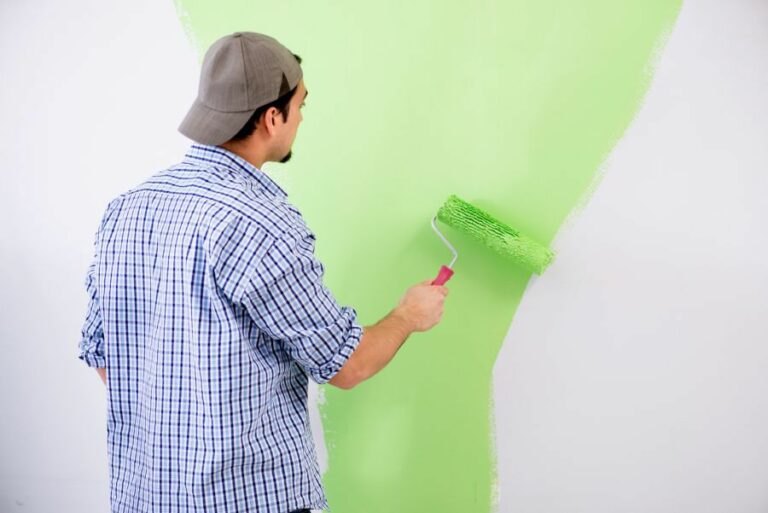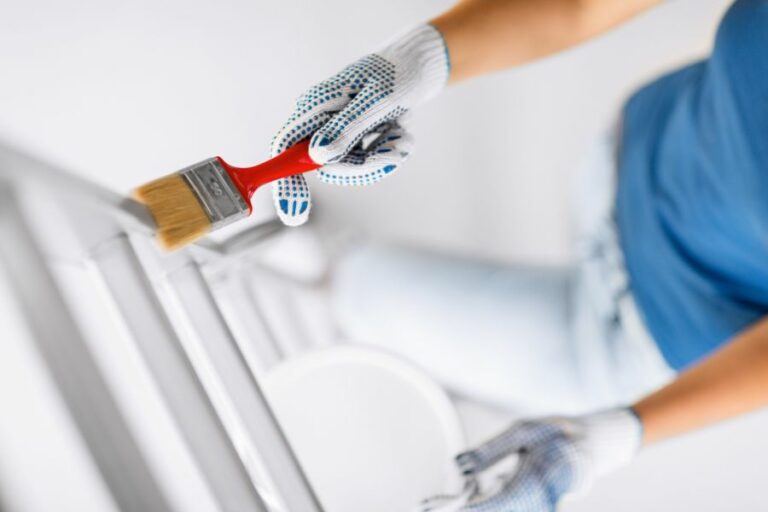How Long Does Indoor Paint Last, 25 Things You Should Know
When it comes to indoor paint, we often wonder just how long it will last before it starts to show signs of wear or fade. Look no further, as I have done the research and have the answer for you! Discover the factors that affect the lifespan of your paint and learn what you can do to ensure it remains vibrant for years to come. Let’s dive in and explore the longevity of indoor paint and how to maximize its life.
How long does indoor paint last?:trong>
Indoor paint lifespan depends on factors like paint quality, surface preparation, and environmental conditions. Generally, oil-based paints last for approximately 15 years, while latex (water-based) paints last for around ten years. Proper surface preparation and maintaining a stable indoor environment can help prolong the paint’s life.

Curious about the longevity of your indoor paint? I’ve got you covered! Dive into this comprehensive guide to discover factors that affect paint’s lifespan, signs of wear and tear, and how to properly maintain its appearance. Keep reading to ensure your walls stay fresh and vibrant!
Contents
- 1 Indoor Paint Lifespan: How Long Does It Last?
- 2 Identifying Expired Paint: Signs to Look For
- 3 Indoor Paint Shelf Life: Can It Go Bad?
- 4 Interior Wall Painting Frequency: When to Repaint
- 5 Decade-Old Paint: Is It Still Usable?
Indoor Paint Lifespan: How Long Does It Last?
Every homeowner and painter needs to be well informed on the life expectancy of various types of indoor paint in order to make a well-informed decision when it comes to repainting their interior spaces.
Factors such as the quality of paint, surface preparation, and environmental conditions will all play a role in determining the longevity of the paint job.
• Factors That Influence the Longevity of Indoor Paint
– Quality of Paint
Paints made from high-quality ingredients and manufacturing processes will last longer compared to those made from cheaper alternatives. High-quality paints typically have a better pigment-to-binder ratio, ensuring a longer-lasting finish.
Paint Type affects the lifespan:
- Oil-based paints: Last for approximately 15 years.
- Latex paints (water-based paints): Last for around 10 years.
It is essential to choose a paint that is specific to the area being painted, taking into consideration the type of surface, moisture levels, and expected wear and tear.
– Surface Preparation
The longevity of a paint job can be significantly impacted by the surface preparation process. Proper surface preparation includes cleaning the surface, ensuring there are no loose or damaged materials, repairing any cracks or holes, and applying a primer if necessary.
These steps create an ideal surface for the paint to adhere to, ensuring a longer-lasting finish.
– Environmental Conditions
The indoor environment plays a crucial role in determining the lifespan of the paint. Factors such as humidity, temperature fluctuations, and exposure to direct sunlight can all contribute to the deterioration of paint over time.
It is essential to maintain a stable indoor environment to prolong the life of the paint job.
• Signs to Look Out for When to Repaint
Even with the best of care, paint will eventually begin to show signs of wear and tear. Here are some common indicators that it’s time to consider repainting:
- Peeling or flaking paint: This is a clear sign that the paint is no longer adhering to the surface and requires attention.
- Fading: This usually occurs in areas exposed to direct sunlight and may require a fresh coat of paint to restore the original color.
- Chalking: This happens when the paint’s binders have broken down over time, leading to a powdery residue on the surface. A fresh coat of paint will resolve this issue.
- Cracks or gaps in the paint: These could be the result of temperature fluctuations or paint aging and need to be addressed with a new coat of paint.
- Changes in Color Preference: Over time, trends and personal preferences change, making it necessary to update the paint color to reflect the desired aesthetic.
• Tips to Prolong the Lifespan of Indoor Paint
To ensure the longest possible life for your paint job, here are some tips:
- Invest in High-Quality Paint: Opt for well-known brands and select a paint that has a higher pigment-to-binder ratio.
- Proper Surface Preparation: Clean and repair the surface, as well as apply a primer if necessary, to ensure the paint adheres optimally.
- Apply the Correct Number of Coats: Typically, two coats of paint are recommended to ensure a uniform finish and adequate protection.
- Maintain a Stable Environment: Control the temperature and humidity levels in the room to minimize the negative effects of environmental conditions on the paint.
- Clean and Maintain Painted Surfaces: Regularly dust and clean painted surfaces to prevent the accumulation of dirt and grime, which can cause the paint to deteriorate faster.
• Conclusion
In conclusion, the lifespan of an indoor paint job predominantly depends on the quality of the paint, the preparation of the surface, and the environmental conditions.
By investing in high-quality paint, properly preparing the surface, and maintaining a stable environment, you can expect your paint job to last anywhere from 10 to 15 years, depending on the type of paint used.
It is crucial to be vigilant for signs of wear and tear and address any issues as they arise to prolong the life of your paint job.
For more in-depth information on paint lifespan and maintenance, visit the EPA’s website on indoor paint for useful resources and guides.
Paint Type | Expected Lifespan |
|---|---|
Water-based (latex) paint | 10 years |
Oil-based (alkyd) paint | 15 years |
Enamel paint | 8-10 years |
Identifying Expired Paint: Signs to Look For
Paint is an essential tool for various projects, ranging from home improvement to arts and crafts. However, over time, paint can go bad, resulting in poor performance and a waste of resources.
• Common Signs of Paint Going Bad
1. Foul Smell
The most obvious sign of bad paint is an unpleasant odor. Over time, bacteria and mold can grow in the paint, causing it to develop a foul smell. If the paint has any hint of a rancid or moldy odor, it should not be used.
2. Separation
Another telltale sign is the separation of the paint components. While it’s normal for paint to separate slightly when stored for an extended period, excessive separation may indicate spoilage. If the paint cannot be effectively mixed back together after thorough stirring, it’s best to avoid using it.
3. Changes in Texture
Gone bad paint often exhibits a change in texture, such as becoming lumpy or overly thick. In addition, it may exhibit a skin or film on the surface. Any of these changes could signal expired paint and should be taken as a warning not to use it.
4. Inability to Dry
If the paint does not dry properly or takes an unusually long time to dry, it might have gone bad. This is especially true if the paint remains tacky or leaves a residue on painted surfaces.
5. Color Changes
Finally, the paint color may change over time if it has gone bad. This can result in faded, uneven, or streaky paint when applied to surfaces. Compare the paint with a sample swatch or a previously painted area to ensure it still matches before use.
• Proper Storage Tips to Extend Paint Life
To prevent paint from going bad, store it in a cool, dry place with a consistent temperature. The following tips can extend the life of your paint:
- Tightly seal the paint cans to avoid air exposure. You can also use plastic wrap under the lid for extra protection.
- Store paint cans upside-down to create a tight seal, preventing air from entering and helping the paint last longer.
- Keep paint away from direct sunlight, as it can cause the paint to degrade and lose its effectiveness.
- Avoid placing paint cans directly on concrete surfaces, as moisture can seep into the can and spoil the paint. Place them on a wooden shelf or pallet instead.
• Disposing of Spoiled Paint
When you determine that a can of paint has gone bad, it’s important to dispose of it properly. Different types of paint require different disposal methods:
1. Latex Paint
If you have spoiled latex paint, first allow it to solidify by mixing it with absorbent materials, such as cat litter or sawdust. Then, leave the can open until the paint hardens completely. You can throw the dried paint in your regular trash, but recycle the empty can if possible.
Alternatively, visit Earth911 to find a paint recycling center near you.
2. Oil-based Paint
The disposal of oil-based paint is more complicated due to the presence of harmful chemicals. It’s considered household hazardous waste and should never be poured down drains or thrown in regular trash.
Many communities have special disposal facilities, so contact your local government (.gov) or waste management agency for instructions.
• In Conclusion
Whether you are a professional painter, a weekend warrior, or a hobbyist, knowing the signs of bad paint can save you time, money, and frustration.
By understanding these signs, handling paint storage properly, and disposing of spoiled paint responsibly, you’ll contribute to a more efficient, eco-friendly, and successful painting experience.
As a final recommendation, always date and label your paint cans, making it easy to keep track of their age and contents, and pay attention to the manufacturer’s recommendations for the shelf life of various paint types. Happy painting!
Signs | Description |
|---|---|
Smell | Bad paint often has a strong, sour smell, which indicates that the paint has gone bad. |
Mold or mildew | Visible mold or mildew on the surface of the paint is a sign that the paint has gone bad. |
Separation | When the paint pigment and solvent have separated and cannot be mixed back together, the paint has gone bad. |
Clumps or chunks | Clumps or chunks in the paint indicate that it has gone bad and is no longer suitable for use. |
Dried or hardened | If the paint has dried or hardened in the can, it can no longer be used and has gone bad. |
Indoor Paint Shelf Life: Can It Go Bad?
As an expert in the field of painting and home improvement, I’ve been asked several times about the shelf-life of indoor paint. Many people wonder whether their leftover paint from a previous project can still be used or whether it may have gone bad over time.
• The Basics: Types of Paint
Before diving into the details, it’s essential to understand the fundamental distinctions between the two primary types of indoor paint: water-based (latex) and oil-based (alkyd). These two paint types have different properties, requiring different storage conditions and exhibiting various signs of deterioration.
– Water-Based (Latex) Paint
Water-based paint is one of the most popular types of interior paint due to its low odor and easy cleanup. It generally dries quickly, is durable, and has a long shelf life when stored correctly.
Water-based paints are susceptible to freezing, and if exposed to extreme temperatures, they can lose their effectiveness.
– Oil-Based (Alkyd) Paint
Oil-based paints, on the other hand, provide a hard, glossy finish and are often used for painting trim, doors, and cabinets. They have a longer drying time and a strong odor compared to water-based paints. Oil-based paints are less susceptible to freezing but can be more sensitive to heat and moisture.
• Factors Affecting Indoor Paint Shelf-Life
Now that we’ve established the basic differences between water and oil-based paints, let’s take a look at the factors that can impact the shelf life of your indoor paint:
– Storage Conditions
The quality of your indoor paint can be significantly impacted by the conditions in which it is stored. Factors such as temperature fluctuations, moisture, and exposure to airplay a crucial role in determining how long your paint will remain viable. Here are some recommendations for proper paint storage:
- Store paint in a cool, dry place away from direct sunlight, heat sources, or freezing temperatures.
- Keep the paint can tightly sealed to minimize exposure to air, which can cause the paint to oxidize and form skin, reducing its usability.
- Be sure to store paint cans upright, as storing them on their side can lead to rusting or leaks.
– Age of the Paint
Over time, even with proper storage, the components within the paint can begin to separate or degrade, leading to a reduction in the paint’s effectiveness. Generally, unopened cans of water-based paint can last up to 5 years, while oil-based paints can last up to 15 years.
However, once a can of paint is opened, it’s best to use it within two years to ensure optimal performance.
• Signs That Indoor Paint Has Gone Bad
To determine whether your indoor paint is still usable, look for these signs of deterioration:
– Unpleasant Odor
Old or spoiled paint may emit a foul or sour odor. If you detect a strong, unpleasant smell when opening the paint can, it’s likely past its prime and should be discarded.
– Separation or Clumping
While mild separation of paint components is expected over time and can be remedied with thorough stirring, more severe separation or the formation of clumps and solids may indicate that the paint has spoiled.
– Mold or Mildew
The presence of mold or mildew in your paint is a clear sign that it is no longer suitable for use. If you notice any signs of mold or a “slimy” texture to the paint, it’s time to dispose of it.
– Inability to Mix
If the paint remains separated and will not mix together after thorough stirring, it has likely become unstable and unusable.
• Tips for Salvaging and Disposing of Old Paint
If your indoor paint shows no signs of spoilage and you’re unsure about its quality, you can try a small-scale test: apply it to a sample surface and observe the results. If the paint adheres well, appears smooth, and dries efficiently, it may still be usable for your project.
However, if it is evident that your indoor paint has gone bad, it’s essential to dispose of it responsibly. Follow local regulations for disposing of paint products, and consider recycling programs or paint disposal facilities in your area.
For additional guidance, check the Environmental Protection Agency’s guidelines on disposing of household hazardous waste.
• Conclusion
Indoor paint can indeed go bad, and several factors influence its shelf life, such as storage conditions, age, and the type of paint. It’s essential to regularly check your stored paint for signs of spoilage and dispose of it responsibly if necessary.
By storing your indoor paint properly and monitoring its condition, you can maximize its lifespan and ensure a high-quality finish for your painting projects.
Interior Wall Painting Frequency: When to Repaint
Painting your home’s interior walls is not only a great way to update its appearance, but it also serves as a protective barrier for the wall surfaces. However, the question that arises is: how often do you need to repaint your interior walls?
• Factors Affecting the Repainting Frequency
– Type and Quality of Paint
The durability and lifespan of a paint job mainly depend on the type and quality of paint used. High-quality paints typically last longer and resist wear and tear better than cheaper alternatives.
Moreover, if you opt for paint with a higher sheen, such as a semi-gloss or gloss finish, it will be more resistant to stains and easier to clean, thereby increasing its longevity.
– Wall Surface Material
Different types of wall materials react differently to paint, affecting how long the paint lasts. For instance, plaster walls are porous and absorb paint well, thus allowing the paint to adhere better and last longer. On the other hand, drywall is less porous and may require more frequent repainting.
– Environmental Factors
Temperature changes, humidity levels, and exposure to sunlight can all have an impact on the longevity of interior paint. Homes in areas with extreme temperature fluctuations or high humidity levels may require more frequent repainting to maintain their appearance.
– Room Usage
The frequency of repainting largely depends on the usage of a room. High-traffic areas, such as hallways, living rooms, and kitchens, are likely to experience more wear and tear, leading to a higher need for repainting. Bedrooms, on the other hand, may require less frequent repainting.
– Maintenance and Cleaning
Regular cleaning and maintenance of painted walls can extend their lifespan. Wiping down walls with a damp cloth to remove dirt and dust can help preserve the paint while also preventing mildew and mold growth.
Moreover, addressing any issues, such as water damage or cracks, in a timely manner can prevent further deterioration of the paint job.
• General Guidelines for Interior Repainting
Although different factors can affect the durability of your interior paint job, here are some general guidelines to help you estimate when it’s time to repaint various rooms in your house.
– High-Traffic Areas
I recommend repainting high-traffic areas, such as hallways, kitchen, and living rooms, every 3-4 years. Given their frequent usage, these areas are prone to scuffs, scratches, and stains that may necessitate a fresh coat of paint.
– Bedrooms and Bathrooms
Bedrooms typically need repainting every 5-7 years, as they experience less wear and tear than other rooms. However, for children’s bedrooms, you might need to repaint more often, depending on how well the walls are maintained.
Bathrooms, on the other hand, should be repainted every 3-4 years, as they’re often exposed to humidity, which can cause paint to peel or become discolored.
– Ceilings
Ceilings generally require repainting less often than walls, as they are not exposed to much wear and tear. You can expect to repaint your ceilings every 7-10 years. However, if you notice discoloration, peeling paint, or mildew growth, it may be a sign that your ceiling needs attention sooner.
• Expert Tips for a Long-Lasting Paint Job
- Choose high-quality paints that are specifically designed for the room you’re painting, such as moisture-resistant paint for humid areas like bathrooms.
- Properly prepare the wall surface by cleaning and repairing any imperfections before painting. This helps the paint adhere better and last longer.
- Apply primer before painting, especially when painting over a dark color or porous surface. Primer helps even out the color and surface, allowing for better paint adhesion.
- Follow proper painting techniques, such as using a roller instead of a brush and applying multiple thin coats instead of one thick coat. This helps ensure a uniform and long-lasting finish.
- Regularly clean and maintain your painted walls to prolong their lifespan and keep them looking fresh.
• Further Resources
For more information on maintaining your home’s interior paint job, visit the website of the Paint Quality Institute, a trusted source of information on paint technology and performance.
In conclusion, how often you need to repaint your interior walls depends on various factors, such as the type and quality of paint, the wall material, environmental factors, room usage and how well the walls are maintained.
By understanding these factors and adhering to the general guidelines and expert tips shared in this article, you can ensure a long-lasting and beautiful paint job for your home’s interior walls.
Decade-Old Paint: Is It Still Usable?
Paint is often thought of as a finite resource with a short shelf life. When repainting a room or renovating a house, the question often arises, “Is 10-year-old paint still good?”
• Factors That Affect the Lifespan of Paint
There are several factors that can cause paint to deteriorate or become unfit for use, including:
– Exposure to the Elements and Temperature
Paints stored in areas exposed to varying temperatures or moisture levels are more likely to go bad. This is especially true for paints stored in garages, basements, or sheds, where climate control is lacking.
– Type of Paint
Different types of paints have varying lifespans. For example, oil-based paints generally last longer than water-based (latex) paints, which typically have a shelf life of between 2 and 5 years.
– Proper Storage Conditions
The way paint is stored plays a significant role in preserving its quality. It should be stored in a sealed container, away from extreme temperatures, moisture, and direct sunlight.
• Assessing the Quality of Old Paint
Though there’s no definitive answer to whether or not 10-year-old paint is still good, there are some signs that can indicate whether it’s usable.
– Check for Mold or Fungal Growth
When opening the paint container, look for any signs of mold or fungal growth. If present, the paint should not be used, as it can negatively impact indoor air quality and may spread mold to other surfaces.
Here’s a helpful guide from the Environmental Protection Agency on understanding mold and its effects on indoor air quality.
– Examine the Texture and Smell
Quality paint should have a smooth, even texture throughout. If the paint has started to separate or has a chunky, uneven texture, it’s no longer suitable for use. Additionally, if the paint emits a strong, unpleasant odor, dispose of it.
– Perform a Consistency Test
Mix the paint well, then dip a paint stirrer or brush into it. Good paint should have a uniform consistency and adhere evenly to the stirrer or brush. If the paint runs off or doesn’t coat the tool uniformly, it’s likely no longer suitable for use.
• Storing Paint for Optimal Shelf Life
The following storage tips can help preserve the quality of your paint for future use:
- Keep paint containers tightly sealed, using a rubber mallet if needed to reseal the lid. Avoid using a hammer, which can damage the lid’s seal.
- Store paint indoors, away from extreme temperatures and moisture levels.
- If possible, store paint off the ground or floor, on shelves or pallets, to minimize temperature fluctuations.
- For oil-based paints, a thin layer of mineral spirits or paint thinner can be poured on top of the paint before sealing the container to create a protective barrier from air exposure.
• Recommendations for Using Old Paint
If you’ve determined that your 10-year-old paint is still good, here are some recommendations based on personal experience.
– Use as a Primer
Old paint is often best suited for use as a primer or preparatory coat, especially if it’s a similar color to the new paint. This can save you money on purchasing a separate primer and ensure proper adhesion of the new paint.
– Test the Paint First
Before committing to using the old paint on a large scale, perform a test on a small, inconspicuous area. This way, you can assess how well it adheres, how it dries, and if there are any issues with mold or odor.
– Consult a Professional
When in doubt, consult with a painting professional or paint supplier. They can provide guidance on the specific type of paint you’re considering using and offer advice on whether or not it’s still suitable for use.
In conclusion, 10-year-old paint may still be good to use, provided it’s been stored correctly and passes thorough inspection. By being vigilant and following the tips and recommendations provided in this article, you can decide whether to use old paint for your next project.







